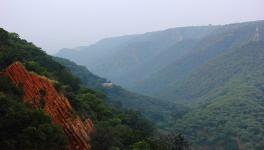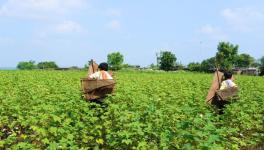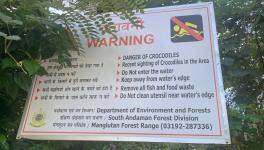As COP26 Looms, India Faces Pile-Up of Environmental Debacles
Image Courtesy: Boolmberg.com
As COP26 kicks off in Glasgow on 31 October, the world will focus on climate change with renewed vigour. Prime Minister Narendra Modi will tell the world what India is doing to tackle the biggest environmental challenge. Union Environment Minister Bhupendra Yadav has been making India’s position on climate change amply clear. He recently said India is on track to increase its green energy capacity to 450 GW by 2030. At present, the installed capacity is over 100 GW, some 25% of the overall capacity. India’s position is to meet nationally determined carbon emission targets, resisting pressure from the west to make steeper cuts, and sooner. India also backs the polluter pays principle, wherein western nations historically and primarily responsible for higher carbon emissions must fund the measures to combat the rise in global temperatures.
For most Indians, the United Nations climate meets are little more than bigwigs talking shop. Extreme weather events make the news more frequently, and there is growing awareness that rapid deforestation, widespread quarrying and unscientific use of land play havoc with the environment. However, there is scant awareness of the connection between extreme events and the growing number of climate refugees within India, or possible future health and economic risks as temperatures rise around the world.
Yet, whatever position India adopts on international fora, it is critical to highlight the domestic pillage of natural resources, which has many Indians lurch from environmental disaster to disaster. India’s problem is not just fossil fuel emissions but the loss of natural forests, rivers, and soil, too. Scientists say losing these resources means contributing to global climate change. For this reason alone, India must change its environmental regulation policies. Climatologists warn that all countries must commit to zero carbon emissions by 2050, but India is heavily dependent on coal energy to meet the needs of its growing economy. India is encouraging coal mining to ramp up energy production to meet the rising industrial and domestic electricity demand. Some experts say India should indeed not commit to zero carbon targets with a deadline before 2065-70, by when it is likely to lift millions out of poverty and have a more stable growth momentum. Ironically, some of India’s oldest forests are unsafe before the mining blitz in coal-rich areas. This loss of habitat and clean sources of water, combined with extensive air pollution, could push millions into poverty.
So, in Glasgow, the Indian contingent may not end up discussing how forest dwellers are getting elbowed out for mega-mining projects. Open-pit coal mines are high methane emitters, and the Indian government is partial towards this form of extraction. The Prime Minister may not have to assure the world that such problems are being tackled by his government. Still, he needs to tell the Indian people why the natural environment is deteriorating around them. Recently, India handed over 80% (14 coal blocks) of extensive contiguous dense forests in Hasdeo Aranya in Chhattisgarh to a prominent coal mining company. The tribals of the region had agitated for ten years against the mine.
Ecologists warn that India lost 14% tree cover during the Covid-19 pandemic and 12% rainforests. In 2014, the central government asked the then Minister of Environment, Prakash Javadekar, to dismantle five crucial laws that were the backbone of Indian environment protection. As a result, India is veering around to just one regulation for all environmental issues. This one-size-fits-all centralised approach will surely fail to address local economic and ecological concerns.
Rapid deforestation has sharply increased the duration and acuteness of heatwaves all over India. In 2019, a severe heatwave gripped two-thirds of the country. Temperatures crossed 45 degrees in Lucknow, Jaipur, Hyderabad, Chandigarh and other cities, while Pune, a hilly town, recorded a high of 43 degrees in May. A few years earlier, it recorded a bitterly cold winter, unprecedented for the region. Fifteen of the world’s warmest cities in April 2019 were in central India, nine of them in one state, Maharashtra. Scientific evidence now also links deforestation and quarrying as the cause of much of the flooding seen in recent years. From Kerala to Uttarakhand, Karnataka to Meghalaya, natural and anomalous weather events, combined with human intervention, have killed hundreds. Over 3,000 died in the Kedarnath disaster in 2013, and there was extensive damage to Himalayan habitations. Many saw in it an early warning of the disasters that regularly unfold today as natural and human factors work together. A World Bank report has highlighted how vulnerable South Asia is to flooding, especially the coastal towns where the sea levels are rising as the global average temperature rises.
Coastal erosion is a serious problem, and again, the main culprits are deforestation combined with the construction of large ports. Last year, severe flooding caused more than 1,000 deaths in the subcontinent. In Bihar, more than 500 people have died this year in the floods. Things are no better along the southern coastline of India. Dr Madhav Gadgil, who wrote the brilliant but unimplemented report on the Western Ghats, squarely blamed the floods on deforestation and “extremely undesirable land use planning” in the Konkan belt—a euphemism for widespread encroachments along river beds and wetlands of the region.
In addition, the economic model focussed solely on resource extraction and unplanned development explains much of the flood devastation in metros, including Chennai, where the 2015 floods were later revealed as a man-made disaster.
Prof Vikram Soni, an environmental physicist at JNU, warns that if India does not change its economic model, the cost of dealing with disasters will overpower the infrastructure-construction model the country is relentlessly pursuing. “The loss of natural infrastructure in terms of good air, natural mineral water, organic soil and food is far greater than the gain from built infrastructure which is increasing fossil fuel emissions,” says Soni.
In Glasgow, Modi will not have to discuss how floods, once they subside, force his country’s citizens to brace for severe winter air pollution that lasts for months. The World Air Quality Report 2020 found India the third most polluted country in terms of PM2.5 matter. Despite slight improvements over the previous year, in 2021, the report found that 22 of the world’s 30 worst cities for air pollution are still in India. Ghaziabad in Uttar Pradesh is the most polluted city in the world. There is a direct correlation between air pollution and disease. The Global Burden of Disease study found in 2017 that ambient air pollution in India is responsible for 3,283 premature deaths every day, or 2.5 million deaths a year. That was a heavier death burden than tuberculosis, HIV-AIDS, and malaria put together, and it has only worsened.
India holds the dubious distinction of having the most polluted rivers in the world. The Niti Aayog warned the central government last year that 70% of water sources are severely polluted. The Water Aids water quality index 2021 ranked India at 120 among 122 countries. Large quantities of sewage and industrial pollutants are dumped in all its major river systems, from the Ganga, Yamuna, Brahmaputra, and Narmada to the Cauvery and Krishna. Governments have spent thousands of crores to clean them, achieving little so far. The Prime Minister’s Lok Sabha constituency, Varanasi, reportedly accounts for 25% of pollutants discharged in the Ganga. In this bleak scenario, river interlinking is a fresh challenge to riverine ecosystems. Ill-conceived schemes to link the Ken-Betwa rivers in Madhya Pradesh are underway after the government launched the projects with much pomp and ceremony on World Water Day 2021. It will require cutting seven lakh trees and submerging 90 square kilometres of the Panna Tiger Reserve, a critical wildlife site. Like most projects of this government, it is getting implemented against the advice of the scientific community.
Himalayan rivers are in crisis due to rapid unplanned road construction and expansion, with little consideration for social and environmental consequences. Frequent use of dynamite, incorrect slope-cutting and indiscriminate muck dumping has sparked numerous landslides. There are mud slips virtually daily, and the muck is precipitating
floods. A field report submitted to the Supreme Court Expert Committee examining the impact of road expansion under the Char Dham Parijoyana found 102 of 174 freshly cut slopes prone to landslides.
Four scientific members of the committee characterise the devastation caused as “...slope after slope came crumbling down, often much deeper into the mountainside than even the 24 meter officially acquired right of way, as water sources got buried, as precious topsoil that takes centuries to form and on which forests grow was ripped off and discarded as muck, as precious, living old and young trees came crashing down, as dormant landslides woke up again and several new ones got triggered, as tons of muck were haphazardly dumped down the valley slopes, choking the rivers and waterways.”
Pristine freshwater, clean air, and organic food and soil are fundamental parameters for a good life. Yet, our government turns a blind eye. Obviously, the Prime Minister cannot tell his audience in Glasgow that Indians are hurtling from environmental disaster to disaster.
The author is a freelance journalist. The views are personal.
Get the latest reports & analysis with people's perspective on Protests, movements & deep analytical videos, discussions of the current affairs in your Telegram app. Subscribe to NewsClick's Telegram channel & get Real-Time updates on stories, as they get published on our website.
























